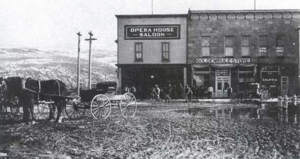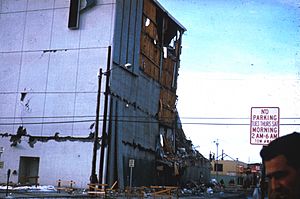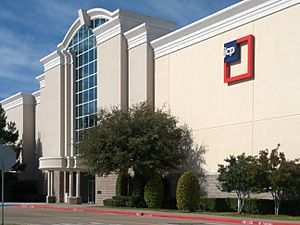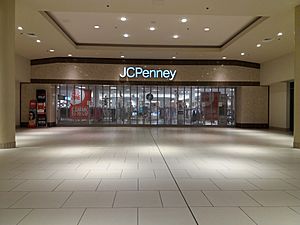JCPenney facts for kids
 |
|
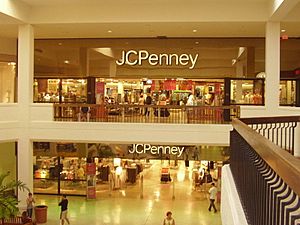
JCPenney store at Aventura Mall in 2006
|
|
|
Trade name
|
JCPenney |
|---|---|
|
Formerly
|
J. C. Penney Company, Inc. |
| Joint venture | |
| Traded as | |
| Industry | Retail |
| Founded | April 14, 1902 Kemmerer, Wyoming, U.S. (J. C. Penney Company) |
| Founders |
|
| Headquarters | Plano, Texas,
U.S.
|
|
Number of locations
|
663 |
|
Area served
|
United States (excluding Hawaii) |
|
Key people
|
|
| Products |
|
| Revenue | |
|
Operating income
|
|
| Total assets | |
| Total equity | |
| Owners | Simon Property Group, Brookfield Asset Management |
|
Number of employees
|
60,000 (Aug. 2021) |
JCPenney, also known as JCP, is a large American department store chain. It has 663 stores across 49 U.S. states and Puerto Rico. You can find many different departments inside JCPenney stores. These include clothes for men, women, boys, girls, and babies. They also sell bedding, home goods, jewelry, shoes, and beauty products. Some stores even have special sections like JCPenney Salon and JCPenney Beauty. You might also find other businesses inside, like Seattle's Best Coffee or Lifetouch portrait studios.
JCPenney stores used to be mostly in downtown areas. But as shopping malls became popular in the 1960s, JCPenney started opening stores there. These stores often became the main anchor stores for the malls. More recently, JCPenney has opened stores in large retail areas called power centers and even stand-alone stores. The company started selling things online in 1998. It has also worked to improve its stores and how it delivers products.
In May 2020, JCPenney faced financial difficulties and filed for bankruptcy protection. Later that year, in September 2020, two big companies, Brookfield Asset Management and Simon Property Group, agreed to buy JCPenney. The deal was approved by a U.S. court.
Contents
JCPenney: A Store's Journey
How JCPenney Started: 1902–1960
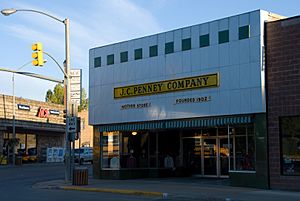
The story of JCPenney began with James Cash Penney. He was born in Hamilton, Missouri. After high school, he worked at a local store. He later moved to Colorado for his health. In 1898, Penney started working for Thomas Callahan and Guy Johnson. They owned dry goods stores called Golden Rule stores.
In 1902, James Cash Penney opened his own Golden Rule store in Kemmerer, Wyoming. He used his savings and a loan to start it. He helped open two more stores. In 1907, he bought out his partners and owned all three stores. By 1912, Penney had 34 stores. In 1913, all the stores became part of the J. C. Penney brand. The first store in Kemmerer is sometimes called the "mother store."
The company officially became J. C. Penney Company in 1913. William Henry McManus was a co-founder. In 1914, the main office moved to New York City. This made it easier to buy and transport goods. By 1917, there were 175 stores in 22 states. In 1924, the 500th store opened in James Cash Penney's hometown. By 1928, when the 1,000th store opened, the company was making a lot of money.
Did you know that Sam Walton, who later founded Walmart, worked at a J. C. Penney store in 1940? By 1941, J. C. Penney had 1,600 stores across all 48 states. The company started advertising nationally in 1956. J. C. Penney credit cards were first given out in 1959.
Expanding What JCPenney Sold

In 1961, J. C. Penney opened its first full-line department store in a shopping center. This store was in Audubon, New Jersey. These new stores sold many more items. They included appliances, sporting goods, tools, and garden supplies. They also had restaurants, beauty salons, and auto centers.
In 1962, J. C. Penney tried opening discount stores called The Treasury. But these did not do well and closed in 1981. In 1963, J. C. Penney started its first catalog. This allowed people to order items from home. In 1969, the company bought Thrift Drug, a chain of drugstores.
Growing Beyond the Mainland USA
In the 1960s, JCPenney expanded to Alaska, Hawaii, and Puerto Rico. Stores opened in Alaska in 1962, Hawaii in 1966, and Puerto Rico in 1968. The Penney Building in Anchorage was damaged by an earthquake in 1964. The company rebuilt it and added Anchorage's first public parking garage. The Hawaii stores closed in 2003. This made Hawaii the only U.S. state without a JCPenney store.
The JCPenney store at Plaza Las Américas in San Juan, Puerto Rico, opened in 1968. It was very large, with three levels. In 1971, an even bigger store opened at Woodfield Mall in Illinois. The Plaza Las Américas store was rebuilt in 1998 and became the largest JCPenney store again.
A Time of Change: 1970s and 1980s
On February 12, 1971, James Cash Penney passed away at 95 years old. The stores closed for his funeral. That year, the company started using "JCPenney" in its advertising. For the first time, its total sales reached $5 billion. The catalog business also started making a profit.
JCPenney had the most stores in 1973, with 2,053 locations. However, the company faced challenges during the 1974 recession. In 1977, J. C. Penney sold its stores in Italy. They also closed their unprofitable Supermarkets Interstate brand. In 1978, the first J. C. Penney store in Kemmerer, Wyoming, became a National Historic Landmark. In 1979, JCPenney stores began accepting Visa cards. MasterCard was accepted the next year.
In 1980, the company closed the Treasury discount stores. They wanted to focus on their main retail stores. In 1983, JCPenney stopped selling appliances, hardware, and auto parts. They also sold their auto centers. That same year, they started selling goods online through a service called Viewtron.
A famous fashion designer, Roy Halston, made a deal with JCPenney in 1983. He created a line of affordable clothes and perfumes called Halston III. This was a big deal because high-end designers usually didn't sell their products at mid-price stores. Even though the line didn't last long, it opened the door for other designers to do similar things later.
In 1984, JCPenney bought a bank. This allowed them to issue their own Mastercard and Visa cards. They also started accepting American Express cards. In 1987, the company announced it was moving its main office to Plano, Texas. By the mid-1980s, all JCPenney stores stopped selling firearms. They also stopped selling outdoor equipment and tools.
Growing and Going Digital: 1990s
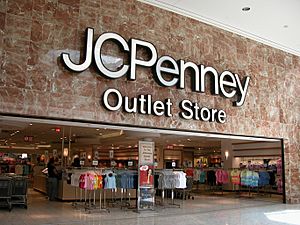
Construction on the new company headquarters in Plano, Texas began in 1990 and finished in 1992. After Sears closed its catalog business in 1993, J. C. Penney became the last catalog retailer in the United States. In 1995, the chain opened a store in Chile. They also expanded their drug store business by buying Fay's Drug and Eckerd. Most of these drug stores were later renamed Eckerd.
In 1998, JCPenney launched its Internet store. This allowed customers to shop from home. Between 1995 and 1998, JCPenney also opened stores in Indonesia. These stores focused on fashion. However, they closed due to economic problems in Asia and riots in Indonesia. JCPenney also left Chile in 1999 because the stores were not making enough money.
JCPenney in the 21st Century
Changes and New Ideas: 2000s

In 2001, J. C. Penney closed 44 stores that were not doing well. They also sold their insurance business to focus more on retail. In 2003, the company opened new, smaller stores in strip centers. These stores were designed to be more convenient for shoppers. In 2004, JCPenney sold its Eckerd drug store division. They also sold their six stores in Mexico. By 2005, J. C. Penney's online store made over a billion dollars in sales for the first time.
In 2007, J. C. Penney launched a new lingerie brand called Ambrielle. It became their biggest private brand ever. J. C. Penney also brought back cosmetics by opening Sephora "stores-within-a-store" inside some J. C. Penney locations. Their store slogan changed from "It's All Inside" to "Every Day Matters." In 2008, they launched the "American Living" brand with Ralph Lauren. This was their largest private brand launch. They also added the "Linden Street" brand for home items.
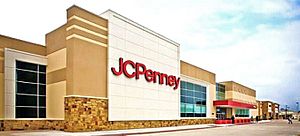
In 2009, J. C. Penney added new brands for young men's clothing. They also made a deal with Seattle's Best Coffee to open cafes inside J. C. Penney stores.
Challenges and Leadership Changes: 2010–2014
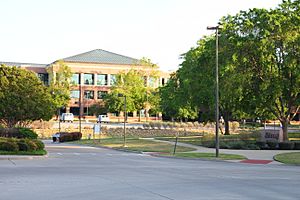
In 2011, J. C. Penney closed its catalog business, which had been running since 1963. This also led to the closure of 19 catalog outlet stores. In June 2011, Ron Johnson, who had helped grow Apple's retail stores, became J. C. Penney's new CEO.
In February 2012, J. C. Penney started a new pricing method. They aimed for "Every Day" prices that were like old sale prices. They also had "Monthly Value" items and "Best Price" days. Prices no longer ended in 9 or 7. In April 2012, some staff were laid off. In June, the company president left. More layoffs happened in July.
In August 2012, J. C. Penney started adding "store-within-a-stores" for different jean brands. However, sales were down significantly. On April 8, 2013, Ron Johnson was no longer CEO. Mike Ullman, a former CEO, took his place. Ullman decided to bring back the promotional pricing strategy that the company was known for.
In January 2014, J. C. Penney announced it would close 33 stores and lay off 2,000 employees. However, their first quarter results in 2014 showed some improvement. In October, Marvin Ellison, a former Home Depot executive, became the new CEO.
Modern Era: 2015–Present
In January 2015, J. C. Penney announced the closure of 39 more stores and layoffs for 2,250 employees. They also stopped selling their "The Foundry Big & Tall Supply Co." brand in separate stores. In 2016, J. C. Penney decided to start selling major appliances again. They also opened a support center in India.
In 2017, J. C. Penney sold its headquarters campus in Plano, Texas, but continued to operate there by leasing it back. In February, they announced plans to close two distribution centers and up to 140 stores. This was to help them focus on expanding their Sephora boutiques and adding Nike and Adidas shops inside their stores.
In 2018, a J. C. Penney store in Puerto Rico closed after Hurricane Maria damaged it. The company reported financial losses and lowered its future predictions. In May, CEO Marvin Ellison resigned. On October 2, Jill Soltau became the new CEO. She worked to improve the company's inventory. By December 2018, J. C. Penney's stock price fell below $1 per share for the first time in its history.
In February 2019, J. C. Penney announced it would stop selling major appliances and limit furniture sales to online and Puerto Rico stores. They also planned to close 27 stores.
COVID-19 and New Owners: 2020
In March 2020, J. C. Penney temporarily closed all its stores due to the COVID-19 pandemic. In May 2020, J. C. Penney filed for bankruptcy protection. They announced plans to close 242 more stores, blaming the pandemic. On May 18, 2020, JCPenney was removed from the New York Stock Exchange.
By June 2020, J. C. Penney reopened many stores. However, some were for final closing sales. More store closures were announced in June and July, including two stores in New York City. On December 30, 2020, Jill Soltau stepped down as CEO.
On September 9, 2020, Brookfield Property Partners and Simon Property Group agreed to buy JCPenney for about $800 million. This deal was approved by the court in November 2020. This purchase was expected to save nearly 60,000 jobs.
Under New Leadership: 2020–Present
In October 2021, JCPenney opened 10 new "shop-in-shop" locations. These featured many different brands, including smaller and diverse brands. Marc Rosen became CEO in 2021.
In April 2022, JCPenney's owners, Simon and Brookfield, offered to buy another department store chain, Kohl's. This was important because Sephora had planned to work only with Kohl's by 2023. If the deal went through, Sephora would stay connected to Simon and Brookfield's stores.
In July 2023, the company moved back to its headquarters in Plano, Texas. Over 2,000 workers are now based there.
Corporate Identity
JCPenney Logos
JCPenney's Own Brands
JCPenney has created many of its own brands over the years. This started with the Marathon Hats line. Here are some of their private brands:
- St. John's Bay: Casual clothes and shoes for men and women.
- St. John's Bay Outdoor: Outdoor clothing for men.
- The Original Arizona Jean Company: Casual clothes and sandals for everyone.
- Xersion: Active and athletic clothing for all ages.
- Worthington: Formal and casual clothing and shoes for women.
- a.n.a: Urban clothing and shoes for young women.
- Ambrielle: Sleepwear, underwear, and swimwear for women.
- Liz Claiborne: Women's clothing.
- Ryegrass: Stylish women's fashion.
- Stafford: Men's formal clothing and shoes.
- J. Ferrar: Men's slim-fitting clothing.
- Collection by Michael Strahan: Men's suits, ties, and cuff links.
- Mutual Weave: Men's denim and casual outerwear.
- Marilyn Monroe: Women's vintage collection.
- Foundry Supply Co.: Men's larger-sized apparel (now in JCPenney stores).
- ThereAbouts: Casual wear for boys and girls.
- Okie Dokie: Newborn and toddler clothes.
- JCPenney Home: Items for the home.
- Linden Street: Bedding.
- Cooks: Cookware.
- Home Expressions: Home goods.
- North Pole Trading Co: Christmas decorations and bedding.
- Marathon Hats: The very first JCPenney private brand.
- Loom + Forge: Modern home decor, bedding, and window items.
Past Businesses of JCPenney
JCPenney used to own or operate several other types of businesses:
- Eckerd Pharmacy: A chain of drugstores sold in 2004.
- The Treasury / Treasure Island: Discount stores that closed in the 1980s.
- JCPenney Insurance: An insurance unit sold in 1989.
- Auto Centers: Car service centers, some with gas stations, closed by the 1990s.
- JCPenney Home Stores: Stores that sold only linens and home decor.
- JCPenney Outlet / JC's 5 Star Outlet: Stores that sold JCPenney items at lower prices, all closed by 2011.
- JCPenney Furniture Outlet: Outlet stores that sold only furniture and rugs.
- JCPenney Restaurants: Some stores had their own restaurants.
- Penncraft Tools: A line of tools that JCPenney sold for a short time.
Historic JCPenney Locations
Some JCPenney locations are so important that they are listed on the National Register of Historic Places (NRHP):
- J. C. Penney-Chicago Store (Tucson, Arizona)
- J. C. Penney Company Building (Shoshone, Idaho)
- J. C. Penney Co. Warehouse Building (St. Louis, Missouri)
- J. C. Penney Building (Newberg, Oregon)
- J. C. Penney Historic District, Kemmerer, Wyoming, which is a very important historic area.
- J. C. Penney House, Kemmerer, Wyoming
Images for kids
-
A former Sephora inside the now-closed JCPenney at Pittsburgh Mills in Tarentum, Pennsylvania.
See also
 In Spanish: J. C. Penney para niños
In Spanish: J. C. Penney para niños


